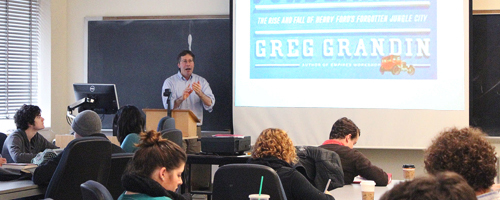Jack Straton, an associate professor of physics and University Studies, teaches the course “General Astronomy,” which is split into two sections. Winter term focuses mainly on the history of astronomy, talking about the planets and the possibility of life on some of the moons of Jupiter or Saturn.
Class profile: ‘General Astronomy’
Jack Straton, an associate professor of physics and University Studies, teaches the course “General Astronomy,” which is split into two sections.
Winter term focuses mainly on the history of astronomy, talking about the planets and the possibility of life on some of the moons of Jupiter or Saturn.
In spring term, the class delves into the sun and stars: the creation and evolution of stars, galaxies, the structure of the cosmos itself, and some of the weird things that are in them, like black holes and even stranger objects.
As a University Studies junior cluster course, anyone working in the Science in the Liberal Arts cluster can take the class. Enrollment usually averages about 115 students.
“It’s very interesting,” Straton said. “There’s something about investigating the cosmos that just turns people on.”
One of the challenges Straton faces as a result of having such a large class is how to create a feeling of classroom community. To solve this dilemma, he has students from prior years join the class as learning assistants. With four people in the room, Straton said it’s much easier to break the class into groups and know that everyone will be attended to.
Class often involves lectures and slides of cosmic photographs taken by the Hubble Space Telescope, but Straton said he tries to enforce as much student involvement as possible.
The most obvious form of student involvement is the projects that are required throughout the course, many of which are group projects.
For one project, students have access to a series of robotic telescopes in Chile; they can log in to the system remotely and choose a galaxy to take a picture of. After submitting the job and waiting a couple of days, the telescopes provide them with three black-and-white images, which they then combine into one color photograph to use and share in class discussion.
Because the class is a junior cluster, most students take it to fulfill that requirement, but anyone is welcome to enroll.
“The prerequisites are an interest and a willingness to deal with a subject matter that’s both inspiring and challenging,” Straton said.
Though there is some math involved, Straton tries to make sure no students completely avoid the class because of it. Since small groups are created within the class, Straton tries to have different skill sets represented in each group so everyone can do their part and no one is left behind.
Another aspect of the class is its involvement for women. Over the years, women have had a history of being a big part of astronomy, and from the 1850s on, women have made significant contributions to the field, something that continues today.
“Women come into the class and they are thrilled to find out that’s the case,” Straton said. “I’m hoping to inspire more women to get into the sciences and for students to share that with their young daughters.”



